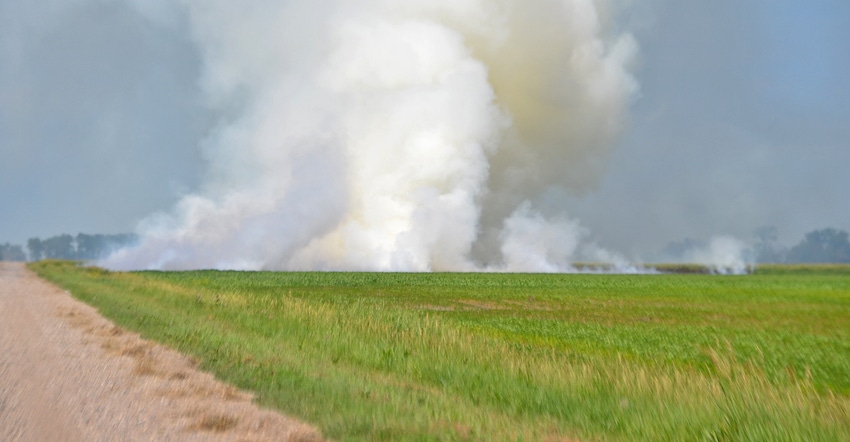January 8, 2018

Grass fires are on the rise in the Great Plains and can cause health problems for cattle, even for the livestock that escape the flames, says Russ Daly, South Dakota State University Extension veterinarian and the state public health veterinarian. The six parts of the cattles’ bodies most affected are:
1. Lungs
Smoke inhalation can cause both immediate and long-term harmful effects to the respiratory system. Cattle that have facial or muzzle burns, or a crusty nose, are more likely to have suffered smoke inhalation than other cattle. The worst short-term effects usually happen during or shortly after the fire.
• First 24 hours. Pulmonary edema — fluid building up in the alveoli (air exchange areas deep in the lungs) due to the irritant effect of smoke. This buildup results in coughing as well as rapid, moist breathing.
• Several hours to several days. The small airways deep in the lungs swell up, making it harder for air to pass through to the alveoli where oxygen exchange occurs. This results in heavy, labored breathing as the animal tries to force air through these partially blocked airways, along with wheezing as the air whistles through the partially blocked airways.
• 4-10 days. Increased potential of pneumonia due to damage to respiratory defense mechanisms.
• 4-6 weeks. healing of the airways is as complete as it will get. Until this time, cattle may be more prone to shortness of breath and acute respiratory collapse if they are exerted or stressed.
• Longer term (months/years). Some survivors may be intolerant of exercise or heat due to longer-term damage to small airways.
Consult a veterinarian for treatment advice. Preventative antibiotics to ward off pneumonia may be an option for some animals, but they also require lengthy slaughter withdrawal periods.
2. Feet
Unless heat damage is immediately severe, cattle might not show signs of feet problems right away. The most common result of severe heat damage is the sloughing of hooves one to three weeks after the fire. Commonly, these animals seem like they are doing fine on their feet until a sudden onset of lameness, accompanied by signs of infection around the coronary band. While this can be confused with infection or foot rot, it usually means that hooves are in the process of sloughing, and antibiotic treatment will not be fruitful. With few exceptions, these animals should be humanely euthanized. If possible, animals that have come through the fire should be provided soft bedding.
3. Teats
Cows with burned teats are candidates for culling. Inflammation due to burns may result in mastitis and non-productive quarters next calving. Producers should especially assess the health of the teat openings when making culling decisions.
4. Skin
Burn wounds in affected cattle should be examined by a veterinarian; severely burned animals are candidates for immediate euthanasia. Minor burns may be treated with topical (surface) treatments, along with systemic antibiotics to minimize wound infection. A source for burn wounds around the head and neck areas is the melting of plastic ear tags during conditions of high heat.
5. Sheaths and scrotums
The extent of burn damage to bulls’ sheaths and scrotums may not be evident for 4-6 weeks. As healing progresses, sheaths should be examined for excessive scarring that may block the opening. Breeding soundness exams should be prioritized for bulls retained in the herd prior to next breeding season.
In some locations, trichomoniasis may be an issue when herds co-mingled due to breached fences. Consult your veterinarian about the possible need for testing before next breeding season.
6. Eyes
Eyes irritated due to smoke and heat may show signs similar to pinkeye. Healing of these conditions will likely take longer than a typical pinkeye case, and in some cases permanent blindness may result. Consult a veterinarian about possible antibiotic treatment of these animals, realizing that any treatment may also have a lengthy slaughter withdrawal.
While a great number of surviving cattle will not show any long-term effects of a wildfire, cattle producers should be aware of the potential of problems down the road. Producers should always consult a local veterinarian to help them make treatment and culling decisions in the best interests of the animal and the operation.
Source: SDSU
You May Also Like




